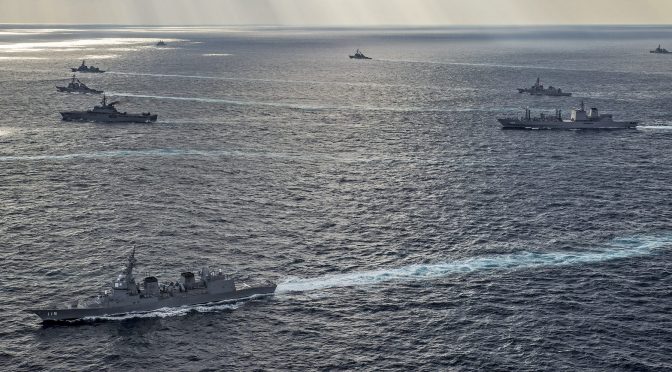By Dmitry Filipoff
This week CIMSEC featured a series of articles submitted in response to the Distributed Lethality Task Force’s Call for Articles issued at the beginning of this month. The Task Force challenged authors to contribute creative thinking and solutions that can help refine the distributed lethality concept. Authors proposed various ideas such as specializing warships and commanders within a surface action group, mitigating logistical challenges through creative basing constructs, conceiving a long-term plan for unmanned-centric distributed operations, and other topics of relevance to distributed lethality. We thank our authors for their contributions and the Distributed Lethality Task Force for its partnership in executing this topic week.
Beans, Bullets, and Benzene: A Proposal for Distributing Logistics by Elee Wakim
“One possible solution harkens back to the late 19th century, when nations desiring to project naval power around the world were confronted with a need for coaling stations to support their relatively short legged ships. The 21st century Navy, borrowing from this concept, could build a series of logistics hubs throughout the Western Pacific.”
Tactical Information Warfare and Distributed Lethality by Richard Mosier
“The Navy strategy is for these SAGs to transit to positions to attack enemy ISR, command and control, and defending forces; and deny them sea control. The success of distributed operations ultimately depends on Information Warfare (IW) operations to deny the enemy the data required to target and attack Surface Action Groups.”
Roles for Up-gunned LCACs in Adaptive Force Packages by Megan McCulloch
“In the event of a conflict within the littorals, operating a group of distributed small crafts may be a better option than sending an Aegis ship or CVN into the fray. One option for adaptive force packages (AFP) might be to employ “up-gunned” LCACs, possibly pairing them with a San Antonio-class LPD or a pair of Platform Supply Vessels (PSV), and an LCS.”
Which Player Are You? Warfare Specialization in Distributed Lethality by Jon Hill
“As easily as a coach can substitute a player, the Navy, too must be ready and flexible. With each ship’s warfare focus clearly defined, commanders will have the ability to add or subtract specific vessels in support of various mission sets and theaters of operation.”
After Distributed Lethality – Unmanned Netted Lethality by Javier Gonzalez
“The real challenge for the Navy then is to continue finding ways to innovate and rapidly incorporate new technologies such as unmanned systems to ensure that distributed lethality does not yield to distributed attrition. The best way to prevent distributed attrition is to fully integrate unmanned technologies into the fleet to ultimately transform distributed lethality into a new concept, hereby referred to as Unmanned Netted Lethality.”
Dmitry Filipoff is CIMSEC’s Director of Online Content. He may be contacted at Nextwar@cimsec.org.
Featured Image: PACIFIC OCEAN (Nov. 19, 2014) U.S. Navy and Japan Maritime Self-Defense Force ships are underway in formation at the conclusion of Keen Sword 15. Keen Sword is a joint-bilateral training exercise involving the U.S. military and the Japan Self-Defense Force to increase combat readiness and interoperability of U.S. forces and the Japan Self-Defense Force. (U.S. Navy photo by Mass Communication Specialist 3rd Class Chris Cavagnaro)

